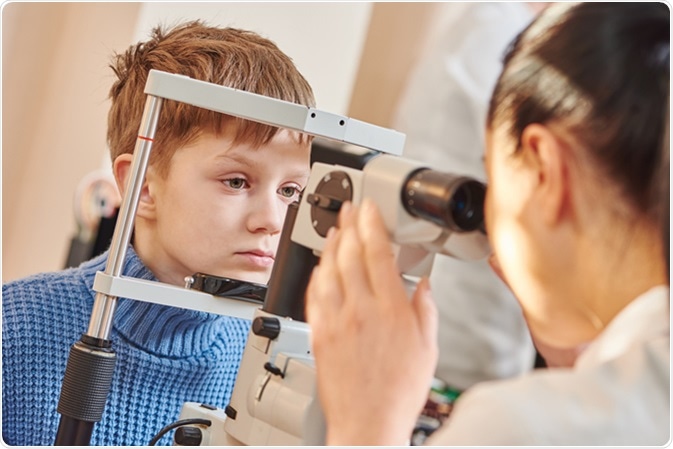Eye Care for Children

Children who have eye problems face multiple barriers such as inability to read blackboards in school, see and recognize others from a distance, and to play some team sports.
The ability to access good eye care can make a great difference in the lives of these children, both in the short and long term.
Learning how to see is a long process which starts even before the child is born, but progresses rapidly through the first six years of life.
Any issue with this learning process during this time can result in the brain compensating around it rather than developing normally, and this is particularly so when a vision problem goes uncorrected for a long time.
This is why children should have regular and complete eye examinations from an early age.

Schedule of Eye Care
All newborns should receive an eye checkup by a qualified practitioner while in the nursery. If the baby is premature or at high risk for any reason, if the family has a history of eye problems, or if there is any obvious problem with the eye, an eye specialist should be consulted.
At some point, the infant’s eye health should be rechecked during the first year, at 3.5 years for visual acuity in addition, and at 5 years for visual alignment besides the other two.
This is followed by regular screenings at school as well as the child’s doctor’s office, but additional visits are advised if headaches or a squint develop.
Disturbing Symptoms
If the child keeps rubbing the eyes, shows any abnormal head position, covers one eye, holds things and books close to see them, blinks a lot, or complains of blurry vision, it may point to an eye problem which should be checked. Squinting, frowning when gazing intently at something, or complaints of itching, burning eyes or dizziness, headache, or nausea after close-up work, all require checking by an eye specialist.
Common Types of Eye Disorders in Children
Refractive errors – defects in eye focus
These include:
- myopia or shortsightedness (near-sightedness)
- hyperopia (long-sightedness or farsightedness)
- astigmatism (due to unequal or irregular spots in the corneal curve or the shape of the eyeball)
- anisometropia (when both eyes show different refractive errors)
Amblyopia
Also called lazy eye, this refers to poor vision caused by lack of brain response to visual inputs from one eye, due to high degrees of refractive error or squint.
Strabismus or squint
Here the eyes are not aligned with each other. The child may have converging or diverging gaze (esotropia or exotropia, respectively), upward or downward gaze (hypertropia or hypotropia, respectively), showing crossed eyes or complaining of seeing double.
Other problems with binocular vision such as:
- Muscle disorders of eye movement
- Accommodative disorders where focusing is poor because of faulty ciliary mechanism or lens structure
- Convergence insufficiency where the eyes work together poorly
Eye disease
This must be looked for in children who were born prematurely:
- Lens opacity or cataract
- Increased intraocular pressure or glaucoma causing permanent optic nerve damage
- Retinitis pigmentosa with retinal degeneration
- Cancers of the retina
- Diabetic retinopathy in young diabetics
- Nerve and brain disorders leading to poor vision
Eye injuries
More than 90 percent of eye injuries are avoidable. The use of safety glasses in situations where eye injury is likely can prevent most of these, such as any activity involving the use of sharp tools, cutting or carving wood or stone, chemicals (including those used around the house), or fireworks.
Concussions and eye symptoms
Concussions are common in children and take longer to heal and half of such children show convergence insufficiency. Parents can help prevent this by early screening in such cases.
Prevention
Children should be taught to take care of their eyes, avoid rubbing them when grit gets into them, and use safety glasses when exposed to eye risks. Proper supervision is necessary in these situations.
Preventing exposure to light in excess
Ultraviolet rays in sunlight may damage various eye components, causing inflammation of the eye, cancer, and damage to the retina. Blue light from monitors, videogames, television, and cell phones is also a threat.
Parents should make sure their children wear either prescription glasses if required or sunglasses in bright sunlight, and teach them not to look directly at the sun. Appropriate wide hats are also recommended for outdoor activity.
Avoiding too much close-up work
Myopia in childhood is increasing and may be linked to children spending more time than ever before on electronic devices. Too much near work stretches the eyeball and promotes high myopia.
Controlling early nearsightedness
High myopia develops more quickly with early nearsightedness and can eventually cause retinal detachment, lens opacities, glaucoma, and failing vision. Proper vision correction with other measures suggested by the eye specialist during regular eye examinations will help delay this.
Sources
- www.aoa.org/…/childrens-vision
- www.cyh.com/…/HealthTopicDetailsKids.aspx
- https://kidshealth.org/en/parents/vision.html
- https://www.nidirect.gov.uk/articles/eye-care-children
- https://my.clevelandclinic.org/health/articles/5445-childrens-eye-care
Further Reading
- All Eye Content
- How Does the Eye Work?
- Types of Eye Allergy
- Managing and Treating Eye Allergies
- Symptoms and Diagnosis of Eye Allergies
Last Updated: Sep 4, 2018

Written by
Dr. Liji Thomas
Dr. Liji Thomas is an OB-GYN, who graduated from the Government Medical College, University of Calicut, Kerala, in 2001. Liji practiced as a full-time consultant in obstetrics/gynecology in a private hospital for a few years following her graduation. She has counseled hundreds of patients facing issues from pregnancy-related problems and infertility, and has been in charge of over 2,000 deliveries, striving always to achieve a normal delivery rather than operative.
Source: Read Full Article